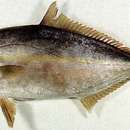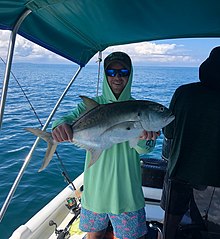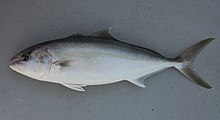en
names in breadcrumbs


Parrish et al. (2008) used CRITTERCAMS fitted on Hawaiian Monk Seals to study interactions during foraging between the seals and large predatory fish, including the Greater Amberjack. Greater Amberjacks are quick and more agile than the seals, but showed much less ability to detect and flush benthic prey from cover. The seals use their whiskers to brush along the bottom and chase out camouflaged prey. They can also dig out wrasses and eels that are buried deep in the sand bottom and they easily flip large rocks (~20 kg) to obtain prey items hiding beneath. The jacks’ awareness of such behavior enables them to swim ahead of the seal and wait near a rock until the seal arrives and moves the rock, flushing prey items from cover. Parrish et al. found that the jacks routinely positioned their mouths within inches of the seal’s nose to maximize their chances of snatching prey items flushed by the bottom-probing of the seal. On numerous occasions they were observed capturing prey before the seal could catch it.
Andaloro and Pipitone (1997) studied the stomach contents of 308 adult Greater Amberjack in the Mediterranean Sea. They found that fish occurred in 79.7% of non-empty stomachs, accounting for 79.5% of prey in number and 71.0% in weight; cephalopods occurred in 26.8% of non-empty stomachs, accounting for 20.5% of prey in number and 29.0% in weight. Overall, pelagic prey items were less frequent than demersal (dwelling near the sea bottom) ones; moreover, males fed much more intensely on demersal prey than did females.
In laboratory experiments, Greater Amberjacks were strictly diurnal feeders and this circadian pattern is apparently driven by a strong endogenous clock, with the pattern persisting for many weeks even under conditions of constant light (Chen et al. 2007).
The Greater Amberjack (Seriola dumerili) is a member of the Jack family, which consists of typically large, fast-swimming fishes of tropical and warm-temperate seas, occurring from coastal bays and lagoons to open ocean (Robins and Ray 1986).
The Greater Amberjack is currently listed by the National Marine Fisheries Service as overfished in the Gulf of Mexico (NMFS 2008, Federal Register, 73 FR 16829-16830).
The Greater Amberjack has a nearly worldwide distribution in warm waters; in the western Atlantic, it is found from Massachusetts (U.S.A.) to southeastern Brazil (Robins and Ray 1986).
The Greater Amberjack is widely distributed in the Mediterranean, Atlantic and Western Pacific (Porta et al. 2009).
The Greater Amberjack is widely distributed in the Atlantic, Pacific, and Indian Oceans (Harris et al. 2007).
Renshaw et al. (2007) developed microsatellite markers for the Greater Amberjack with the hope that they would be useful for conservation and population genetic studies of both wild and "domesticated" stocks of this fish.
The Greater Amberjack is found in the open sea to 200 fathoms; small specimens occur in shallow water (Boschung et al. 1983).
In a study of Greater Amberjacks in the southeastern United States (Manooch and Potts 1997), the oldest individual examined was 17 years old. In another study, in the north-central Gulf of Mexico, maximum age was estimated to be 15 years (Thompson et al. 1999). In a study of nearly 2000 specimens collected from North Carolina to the Florida Keys, age estimates ranged from 1 to 13 years (Harris et al. 2007).
The Greater Amberjack is mostly brownish (darker above, whitish below), often with a broad, diffuse, yellowish stripe along the midside. A dark olive-brown stripe extends from the snout through the eye to the point where the spinous dorsal fin begins. The spinous dorsal fin is low, but easily seen at all sizes (usually with 7 spines). The front lobe of the soft dorsal and anal fins is not very high; the outer edge is curved, but not sickle-shaped. The head is bluntly pointed. There is a fleshy keel on each side of the causal peduncle. There are no detached finlets. (Robins and Ray 1986)
The maxilla (the rear bone of the upper jaw) is very broad posteriorly (i.e., toward the rear) reaching the middle of the eye. The pectoral fins are shorter than the head, equalling the pelvic fins. The second dorsal fin is much longer than the anal fin. The caudal peduncle is relatively deep, with grooves present above and below at the base of the caudal fin. (Boschung et al. 1983)
Based on an examination of about 2500 Greater Amberjack collected from North Carolina to the Florida Keys, Harris et al. (2007) estimated potential fecundity at 18,271,400 to 59,032,800 oocytes for 930 to 1,296 mm specimens and from 25,472,100 to 47,194,300 oocytes for ages 3 to 7. Peak spawning off south Florida and the Florida Keys occurred during April and May.
The flesh of the Greater Amberjack can cause ciguatera poisoning (Robins and Ray 1986; Poli et al. 1997) if it has fed on other fishes that have been contaminated with toxins produced by certain dinoflagellate algae, notably Gambierdiscus toxicus.
The Greater Amberjack may reach 1.5 meters and 80 kg (Robins and Ray 1986).
The Greater Amberjack is an important game fish (Robins and Ray 1986).
The Greater Amberjack is of high commercial value in worldwide fisheries. The interest in this species in aquaculture is increasing due to its fast growth, low mortality, and good performance, having now been cultured successfully in Japan for some years, as well as in the Mediterranean and Atlantic. (Porta et al. 2009 and references therein)
The greater amberjack (Seriola dumerili), also known as the allied kingfish, great amberfish, greater yellowtail, jenny lind, Sea donkey, purplish amberjack, reef donkey, rock salmon, sailors choice, yellowtail, and yellow trevally, is a species of predatory ray-finned fish in the family Carangidae, the jacks and pompanos. It is found in temperate, subtropical, and tropical seas around the world. It is a popular quarry species for recreational fisheries and is important in commercial fisheries. It is the largest species in the family Carangidae.
The greater amberjack is a large predatory fish which has a body colouring which varies from brownish to bluish-grey on the dorsal surfaces contrasting with the silvery-white underparts. A diagonal sooty stripe starts at the snout and runs along the centre of the back dorsal fin; another dark stripe runs from the upper jaw, across the eye to in front of the first dorsal fin. Some fish may show a light yellow to reddish-brown stripe along the flanks.[3] The fins are dusky in colour. The second dorsal and anal fins have a low anterior lobe.[2] Small juveniles have clear fins[3] and a series of five vertical bands along the body and a sixth band on the caudal peduncle.[4] The shape of the body is elongated and fusiform and it is of moderate depth and laterally compressed, and has a covering of small cycloid scales.[4] The largest fish have been measured at 190 cm (75 in) in total length, but the more typical length found is 100 cm (39 in), while the largest published weight is 80.6 kg (178 lb).[2]
The greater amberjack has an almost circumglobal distribution in the world's subtropical and tropical seas and oceans. In the Indian Ocean, it is found along the African coast from South Africa east through the Persian Gulf to Western Australia and southern Japan, reaching the Hawaiian Islands and Micronesia in the Pacific Ocean. It reaches as far south as the island of Tasmania off the coast of Australia. In the western Atlantic Ocean, this species is found around Bermuda and on the North American coast as far north as Nova Scotia extending south as far as Brazil, including the Gulf of Mexico and the Caribbean Sea. In the eastern Atlantic Ocean, it has been recorded as a vagrant as far north as the British Isles and is found off in the Bay of Biscay south to Morocco and in the Mediterranean Sea. It may occur along the west African coast, but may be confused with the similar Seriola carpenteri.[2][3][1][5]
The greater amberjack is found as solitary individuals or in small to moderate-sized schools, which are epibenthic and pelagic and occur in the vicinity of reefs, deep offshore caves, drop-offs, rocky outcrops, and deep seaward reefs. It sometimes enters coastal bays, while the juveniles are infrequently recorded quite far well out to sea where they shelter among floating algae, such as Sargassum, and debris.[3] It can also be found over wrecks. Smaller individuals, less than 3 kg (6.6 lb), can be caught in shallow water, while the larger fish prefer deeper water, normally 18–72 m (59–236 ft) and have been recorded at depths of 360 m (1,180 ft).[1]
Greater amberjacks are opportunistic predators when they are adults, which prey on benthic and pelagic fishes, as well as cephalopods and crustaceans. Common fish prey species include the bigeye scad (Selar crumenophthalmus) and sardines (Sardinella aurita and Sardina pilchardus). The juvenile fish feed on plankton, including the larvae of decapods and other small invertebrates.[6] The juveniles switch to feeding on larger prey such as larger benthic and nektonic organisms when they attain a length of 8–12 cm (3.1–4.7 in), and once they have grown larger than 12 cm (4.7 in), they restrict their prey choice to animals that swim on or over the substrate; when they attain 20 cm (7.9 in), they are mainly piscivorous and at this size, they move from open waters to more coastal areas.[4]

S. dumerli is gonochoric, meaning that the males and females are separate and determined at birth, and no sexual dimorphism exists other than size. The sexes begin to differentiate around 4–5 months of age when they attain a length of 24–26 cm (9.4–10.2 in). In the Mediterranean, they reach sexual maturity at 4 (males) and 5 (females) years of age when they attain a length around 109 and 113 centimetres (43 and 44 in) in length in males and females. In western Atlantic populations, the males are mature after three years and 80 cm (31 in) and the females after four years of age and attaining 83 cm (33 in).[4] This species has been observed to show pair courtship off Belize where schools numbering around 120 individuals were found and pairing mainly occurred during when the Moon was either full or waning and between February and October. Half of the males are sexually mature at 64.6 cm (25.4 in) fork length for males; half of the females are sexually mature on attaining 73.3 cm (28.9 in) fork length. This is a highly productive fish; a single female may lay 18 to 59 million eggs in a single spawning season. Off the coast of Florida, spawning peaks in April and May, each female is estimated to spawn once every four to five days during the spawning season, lasting around 60 days.[1] In the Mediterranean, spawning takes place in June and July.[4] Spawning occurs over such habitats as reefs and shipwrecks, demonstrated by the abundance of juveniles in these habitats in the summer following the spring spawning in the western Atlantic.[6]
The eggs are 1.9 mm (0.075 in) in diameter, and after spawning, the embryos take around 40 hours to develop at 23 °C (73 °F), and the newly hatched 2.9-millimetre (0.11 in) larvae take 31–36 days to develop into juveniles.[2] They can live up to 17 years.[7]
Greater amberjack are preyed on by larger fishes including the yellowfin tuna (Thunnus albacares) and European hake (Merluccius merluccius), and seabirds including the brown noddy (Anous stolidus) and sooty tern (Sterna fuscata). Tapeworms are occasionally recorded as infesting this species, these worms being harmless to humans, albeit rather unappetising. The monogenean Zeuxapta seriolae has been documented as living as a parasite on the gills of these fish.[6][8]
The greater amberjack is an important food fish and is a commercial quarry species, and the species has been used in aquaculture in the Mediterranean since the 1980s.[4] As a predatory fish, it requires protein and lipids sourced from other fish, so questions have arisen over the sustainability of its culture.[4] It is also a popular game species for angling,[6] having earned the nickname "reef donkey" for its stubborn fight.[9] The meat is used for sushi and sashimi in Japan,[4] while in Florida and Mexico, its flesh is marketed fresh and can be fried, broiled, baked, or grilled.[6] Angling techniques used to catch greater amberjacks include trolling at the surface with various artificial lures and natural baits. They are often incidentally caught by anglers who are fishing the seabed for snappers and groupers.[10]
The greater amberjack was formally described as Caranx dumerili by French naturalist Antoine Risso in 1810, with the type locality given as Nice, France.[11] The binomial consists of the generic name, which is the Italian name for this species, while the specific name is patronymic, the identity of the person honoured in the patronym was not identified by Risso, but is almost certainly French zoologist André Marie Constant Duméril (1774–1860), who was the father of another well-known French zoologist Auguste Duméril (1812–1870).[12] It is the type species of the genus Seriola[13]
 Greater Amberjack ( Seriola Dumerili ). Gulf of Mexico. Credit: SEFSC Pascagoula Laboratory; Collection of Brandi Noble, NOAA/NMFS/SEFSC. Notice the elongated body, the short very streamlined dorsal and Pelvic Fins and the Tuna like tail.
Greater Amberjack ( Seriola Dumerili ). Gulf of Mexico. Credit: SEFSC Pascagoula Laboratory; Collection of Brandi Noble, NOAA/NMFS/SEFSC. Notice the elongated body, the short very streamlined dorsal and Pelvic Fins and the Tuna like tail. The greater amberjack (Seriola dumerili), also known as the allied kingfish, great amberfish, greater yellowtail, jenny lind, Sea donkey, purplish amberjack, reef donkey, rock salmon, sailors choice, yellowtail, and yellow trevally, is a species of predatory ray-finned fish in the family Carangidae, the jacks and pompanos. It is found in temperate, subtropical, and tropical seas around the world. It is a popular quarry species for recreational fisheries and is important in commercial fisheries. It is the largest species in the family Carangidae.